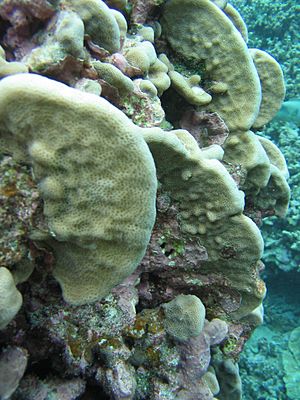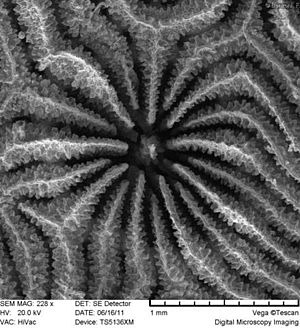Porkchop coral facts for kids
Quick facts for kids Porkchop coral |
|
|---|---|
 |
|
| Scientific classification |
Pavona duerdeni, also known as the porkchop coral, is a type of coral. It forms large groups of cream-colored shapes that look like lobes or discs. These corals grow in big colonies, which are divided into ridges or small hillocks.
Even though it's not seen very often, you can find porkchop coral in places like Hawaii, the Indo-Pacific, and the Tropical Eastern Pacific. These corals can form some of the biggest coral colonies. They grow slowly, which is why their skeletons are very dense and strong. Their surface looks smooth because of the tiny corallites that grow on them.
Contents
What is Porkchop Coral Like?
Appearance and Size
Pavona duerdeni is usually a solid grey color. It can also have yellow and brown shades on its surface. The coral gets these colors from tiny yellow-brown organisms called zooxanthellae that live inside it. These organisms are like tiny plants.
A typical Pavona duerdeni can grow quite large. It can be over 1.5 meters (about 5 feet) tall and 3 meters (about 10 feet) wide! These corals are Hermatypic corals. This means they are part of the Scleractinia group, which builds hard, stony skeletons. These skeletons form the base of coral reefs.
Small structures called corallites are found on the coral's surface. They are made of calcium carbonate, which is a hard, protective material. These corallites protect the coral's soft parts, called polyps. This is why the coral looks so smooth. The polyps usually come out during the day. But if the water moves too fast, they pull back inside their corallites.
Pavona duerdeni colonies are known as massive corals. They are often shaped like boulders. These large structures are divided into small hillocks with uneven ridges. Massive corals grow slower than smaller corals. Because they are so strong and stable, big waves usually don't damage them. However, a very strong wave could dislodge them from where they are attached.
How to Identify This Coral
Pavona duerdeni belongs to a group called Anthozoans. These are marine animals without backbones. When they are grown, they are attached to the seabed. But their young, called larvae, float freely in the ocean as part of the plankton.
Since Pavona duerdeni is a Scleractinia coral, it's a stony or hard coral. It's also a colonial coral. This means a single coral polyp settles down and starts to build a calcium carbonate skeleton around itself. Then, more polyps grow, forming a colony.
As part of the Agariciidae family, Pavona duerdeni is a reef-building coral. It has a special relationship with zooxanthellae. These tiny organisms help the coral get the food it needs. Corals in the Pavona group have a flower-like pattern on their surface. This happens because the corallites are connected to each other without walls between them.
Fossils found in Hawaii show that Pavona duerdeni lived during the Pleistocene epoch. This was a long time ago, between the Pliocene and Holocene periods.
Where Porkchop Coral Lives
Geographic Location
Pavona duerdeni is not very common, but it has been found in several places. These include Hawaii, the Indo-Pacific, and the Tropical Eastern Pacific.
Large groups of Pavona duerdeni have been seen in:
- The Gulf of Panama
- The Carrizales, Colima coral reef in Western Mexico
- The Koh Tao reef in Thailand
- The Johnston Atoll reef
- The Hawaiian Archipelago and the Emperor seamount chain
Habitat
Pavona duerdeni lives in shallow reef areas. It forms large colonies on flat, shallow surfaces. You can find them starting at about 5 meters (16 feet) deep. They become more common between 9 and 10 meters (30-33 feet) deep.
These corals are known for building reefs. They live in shallow ocean environments. They can be found attached to reef structures or rocky areas. They also live in areas with rubble or soft bottoms. The best temperatures for this coral are between 25 °C and 29 °C (77 °F and 84 °F). They need a minimum average temperature of 18 °C (64 °F) to survive.
Pavona duerdeni helps create a home for many other living things. The coral polyps, along with tiny organisms like bacteria, fungi, and viruses, form a special team. This team helps with important processes like making nitrogen and breaking down dead organic material in the ocean.
How Porkchop Coral Lives
Special Partnerships
Coral polyps (animals) and zooxanthellae (tiny single-celled organisms) have a special relationship called mutualism. This means they both help each other. The zooxanthellae make food using sunlight, and the coral uses this food to live and grow. This partnership is very important for the life and growth of tropical coral reefs.
When corals get stressed, like from too much heat, they can push out the zooxanthellae cells. This makes the coral turn white, a process called "coral bleaching." If a coral is completely bleached, it has lost all its zooxanthellae cells.
Reproduction and Life Cycle
Like other Anthozoa corals, Pavona duerdeni releases its eggs and sperm into the water at the same time. After the eggs are fertilized, they turn into tiny larvae called planula. These larvae have flat bodies and use tiny hairs (cilia) to swim freely in the water. Ocean currents help carry them around.
Once the larvae are fully grown, they settle down on the seabed. They attach themselves to a surface and start to grow into coral polyps. Since these corals are hermatypic, they build reefs by creating hard, stony material. Over time, the coral grows into a massive, boulder-sized formation. These large structures provide homes and support for many other ocean creatures.
Threats to Porkchop Coral
Pavona duerdeni faces several dangers. One is called White Plague Disease. This disease was first seen in the 1970s. It kills coral tissue very quickly, causing big declines in reefs worldwide. Corals with this disease lose their tissue fast, leaving a clear white line. This white line separates the healthy, colored parts from the dying parts. Pavona duerdeni and other Pavona species have been badly affected by this disease off the coast of Thailand.
Other challenges that harm Pavona duerdeni and its habitat include:
- Climate Change: Rising ocean temperatures due to climate change stress the coral. If the water gets too hot, the coral's relationship with its zooxanthellae breaks down. This leads to "coral bleaching". The coral expels the zooxanthellae and turns completely white.
- Ocean Acidification: When the ocean absorbs too much carbon dioxide (CO2) from the air, it becomes more acidic. These acidic conditions can dissolve the coral skeletons that make up the reef. This also makes it harder for corals to grow and reproduce, threatening their survival.
Images for kids
See also
 In Spanish: Pavona duerdeni para niños
In Spanish: Pavona duerdeni para niños





